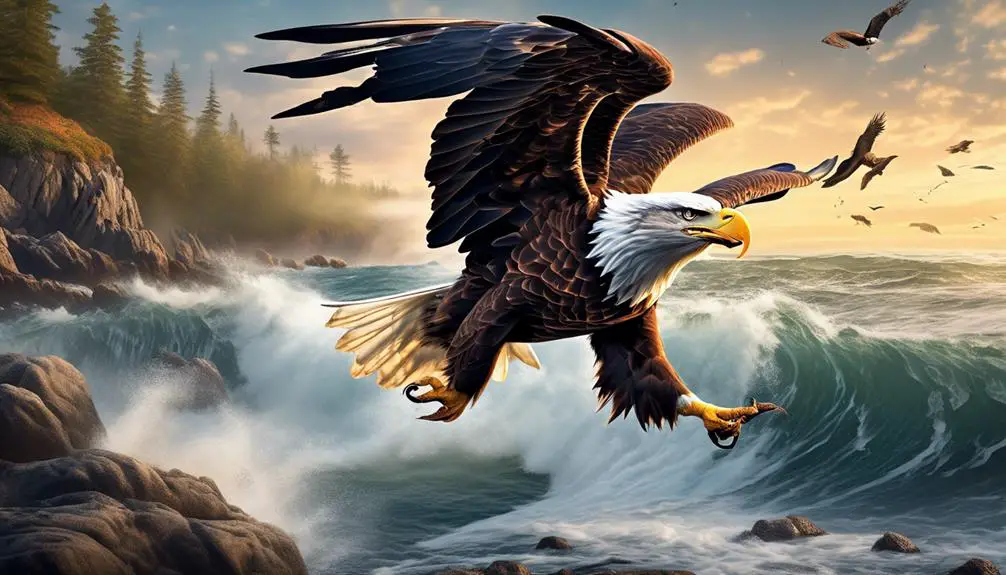Imagine yourself standing on a sandy beach, the salty breeze gently caressing your skin as you watch the rhythmic crash of the waves. But have you ever wondered what lies beneath the surface, hidden from our view?
Beneath these tranquil waters, a fierce battle for survival ensues, and crabs are at the heart of it all. These fascinating crustaceans are hunted by a diverse array of predators, each with their own unique strategies and adaptations.
From the deep-sea dwellers to the coastal hunters, the list of animals that relish a crab feast is as intriguing as it is extensive. But who are these predators? What drives them to seek out these delectable crustaceans?
Get ready to uncover the secrets of the creatures that share a taste for crabs, as we embark on a thrilling journey into the captivating world of ‘What Eats Crabs? Animals That Eat Crabs!’
Octopuses
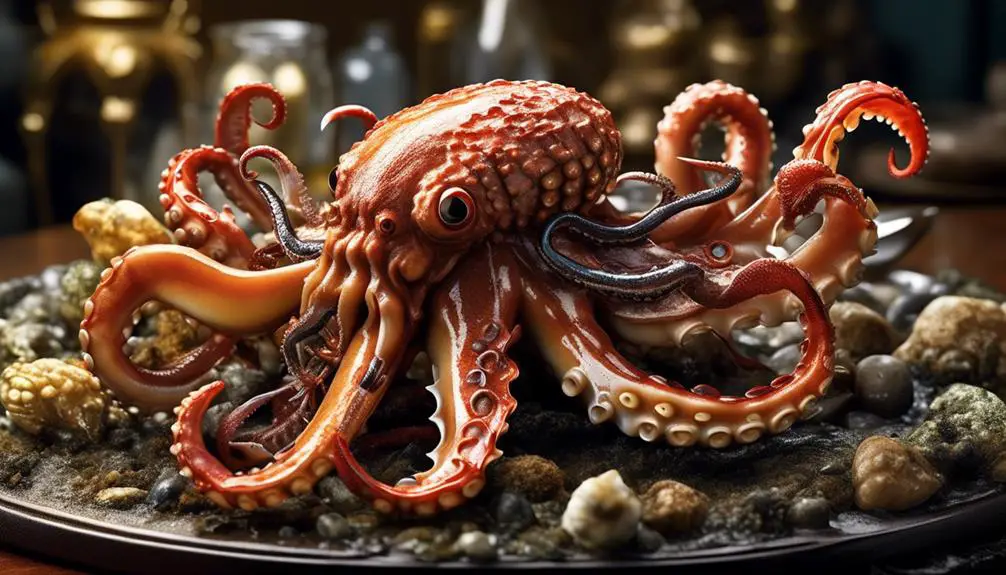
Octopuses, as mollusks in the Cephalopoda class, actively prey on a variety of marine creatures including starfish, clams, snails, crayfish, and, of course, crabs. With their eight limbs and beaked mouth, octopuses are formidable hunters. They possess exceptional intelligence and are highly skilled in capturing their prey.
Octopuses use their siphon for both locomotion and respiration, allowing them to move quickly and efficiently in search of food.
When hunting for crabs, octopuses employ various strategies. They have the ability to change the color and texture of their skin, enabling them to blend seamlessly into their surroundings. This camouflage allows them to approach their unsuspecting prey undetected. Once in close proximity, octopuses use their strong arms to grasp the crab and immobilize it. Their beak is then used to break open the crab’s hard exoskeleton, providing access to the succulent flesh inside.
Octopuses are known for their impressive problem-solving skills and adaptability. They have been observed using tools, such as rocks and coconut shells, to create shelters and even to trap their prey. This level of intelligence and resourcefulness contributes to their success as crab predators.
Hawks
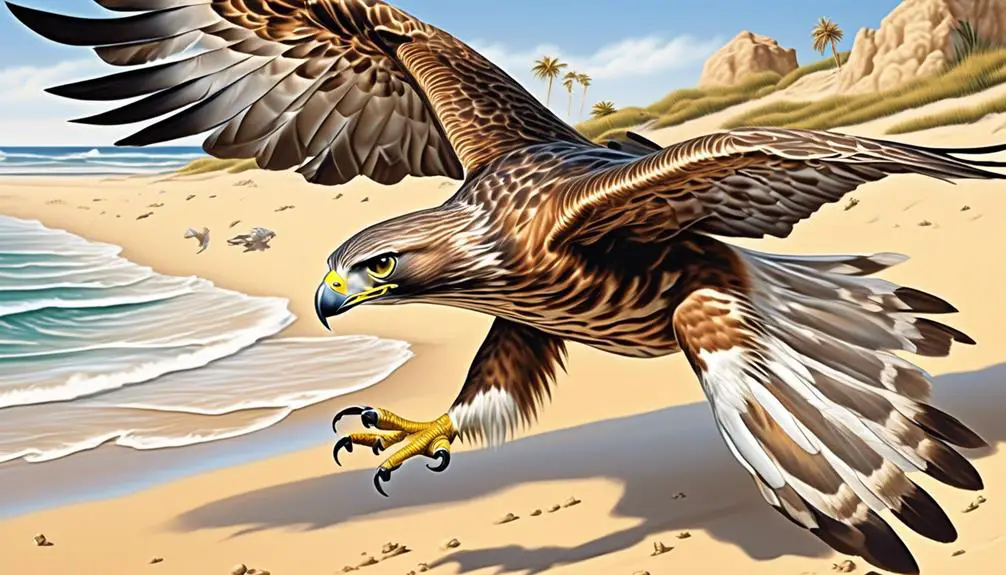
Hawks, belonging to the Accipitridae family, are diurnal raptors known for their sharp vision and migratory patterns. These birds of prey have adapted to various habitats and are found on every continent except Antarctica.
Hawks primarily feed on small prey, including frogs, rodents, grasshoppers, snails, and crabs. Their sharp talons and hooked beaks enable them to capture and kill their prey efficiently. Hawks are skilled hunters and often use their exceptional vision to spot their prey from high vantage points. They then swoop down with great speed and precision to catch their target.
Some hawks also consume larger prey such as lizards, snakes, and crayfish. During their seasonal migrations in spring and autumn, hawks may encounter abundant sources of crabs in coastal areas. These crustaceans provide an additional food source for hawks during these times.
Hawks play an important role in controlling crab populations, helping to maintain the balance of ecosystems in their habitats.
Sea Turtles
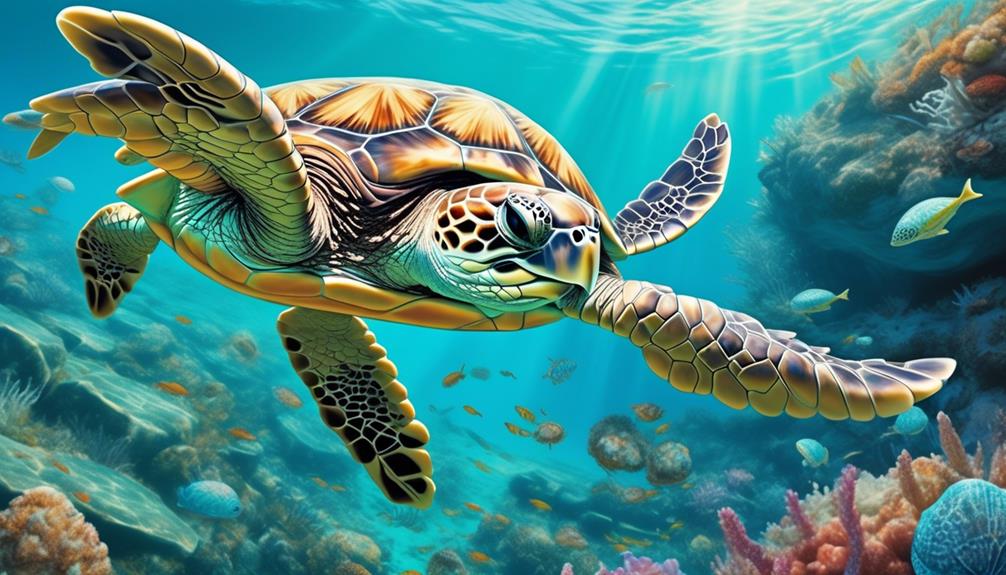
Sea turtles, which are reptiles in the Testudines order, exhibit varied diets.
Some species of sea turtles, such as flatback and leatherback turtles, consume crabs as part of their diet. Additionally, loggerhead, hawksbill, green, and Kemp’s ridley turtles have also been observed consuming crabs.
These sea turtles display different preferences for crab species, showcasing the diverse feeding habits within this group.
Sea Turtle Diet
Sea turtles have diverse diets, consuming a variety of prey items including crabs. Different species of sea turtles exhibit varying dietary preferences.
Flatback and leatherback turtles are known to consume crabs as part of their diet. Loggerhead, hawksbill, green, and Kemp’s ridley turtles also feed on crabs. These marine reptiles are equipped with powerful jaws and sharp beaks, which allow them to crush and consume the hard exoskeletons of crabs.
Sea turtles are opportunistic feeders, and their diet may also include other crustaceans, mollusks, fishes, and seagrasses. They play a crucial role in maintaining the balance of marine ecosystems by controlling the populations of their prey species.
Understanding the dietary habits of sea turtles is essential for their conservation and the preservation of their habitats.
Crab Consumption Patterns
Crabs are an important component of the diet for several species of sea turtles. These turtles, including the flatback, leatherback, loggerhead, hawksbill, green, and Kemp’s ridley turtles, rely on crabs as a source of nutrition. Sea turtles are known to consume various species of crabs, which provide them with essential nutrients and energy.
To provide a clearer understanding of the crab consumption patterns among sea turtles, the following table displays some of the crab species consumed by these turtles:
| Sea Turtle Species | Crab Species Consumed |
|---|---|
| Flatback | Blue Swimmer |
| Leatherback | Horseshoe |
| Loggerhead | Ghost |
| Hawksbill | Fiddler |
| Green | Sand |
| Kemp’s ridley | Spider |
These crab species are just a few examples of the wide variety that sea turtles consume. Sea turtles play a vital role in maintaining the balance of marine ecosystems by controlling crab populations and contributing to the overall health of the ocean. Understanding their crab consumption patterns helps us comprehend the intricate relationships between species and the importance of conserving sea turtle populations.
Crab Species Preferences
Among the various species of sea turtles, their preferences for different crab species as part of their diet provide insights into their feeding habits and ecological roles.
Flatback and leatherback turtles are known to consume crabs. Flatback turtles primarily feed on small crabs, such as the ghost crab (Ocypode spp.) and fiddler crab (Uca spp.), while leatherback turtles have a preference for blue crabs (Callinectes sapidus) and horseshoe crabs (Limulus polyphemus).
Loggerhead, hawksbill, green, and Kemp’s ridley turtles also include crabs in their diet. Loggerhead turtles consume blue crabs, spider crabs (Libinia spp.), and lady crabs (Ovalipes spp.). Hawksbill turtles prefer the diet of sally lightfoot crabs (Grapsus spp.) and red rock crabs (Grapsus spp.). Green turtles feed on green crabs (Carcinus maenas) and ghost crabs. Kemp’s ridley turtles consume a variety of crab species, including blue crabs, spider crabs, and mud crabs (Panopeus spp.).
These preferences for different crab species highlight the diverse feeding habits and ecological roles of sea turtles in marine ecosystems.
Dolphins
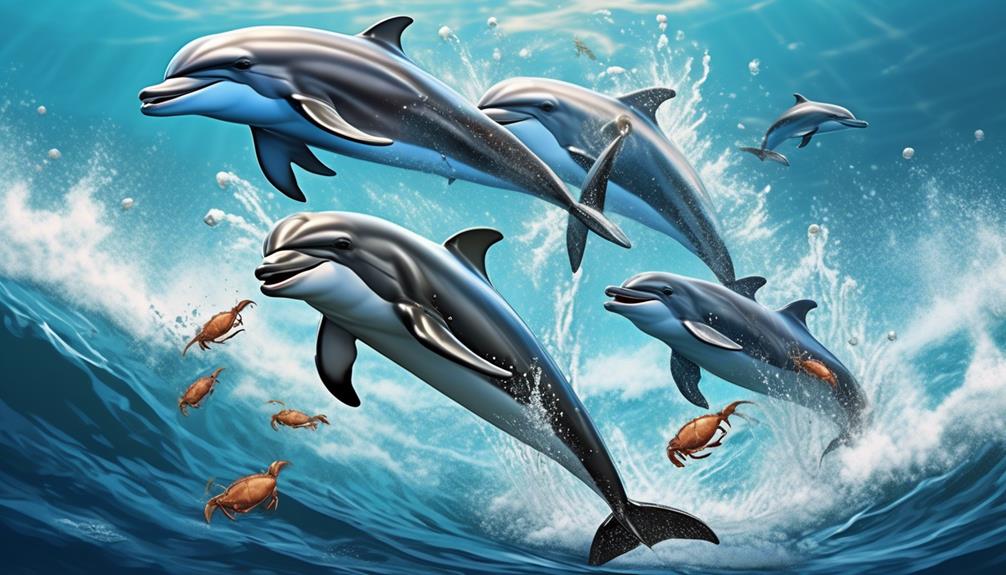
Dolphins, highly intelligent aquatic mammals of the Cetacea infraorder, exhibit a diverse and varied diet that includes various species of fish, squids, and crustaceans such as crabs and shrimps. Their ability to consume a wide range of prey items is due to their specialized feeding adaptations, such as sharp teeth and a flexible feeding behavior. Dolphins are known to hunt and capture their prey using a combination of echolocation, teamwork, and agility in the water.
To further understand the diet of dolphins, let’s take a closer look at their feeding habits in a table format:
| Dolphin Species | Prey | Dietary Preferences |
|---|---|---|
| Bottlenose Dolphin | Fish (e.g., herring, mackerel) | Primary diet consists of fish, but may also consume crustaceans such as crabs and shrimps. |
| Orca Dolphin | Squid, fish, and marine mammals | A diverse diet that includes fish, squids, and occasionally crustaceans like crabs. |
| Spinner Dolphin | Small fish and squid | Mainly feeds on small fish and squid, but may also consume crustaceans opportunistically. |
It is important to note that the specific dietary preferences of dolphins may vary depending on their habitat, availability of prey, and individual preferences. Dolphins are highly adaptable hunters, capable of adjusting their diet to ensure their survival in various marine environments.
Herons
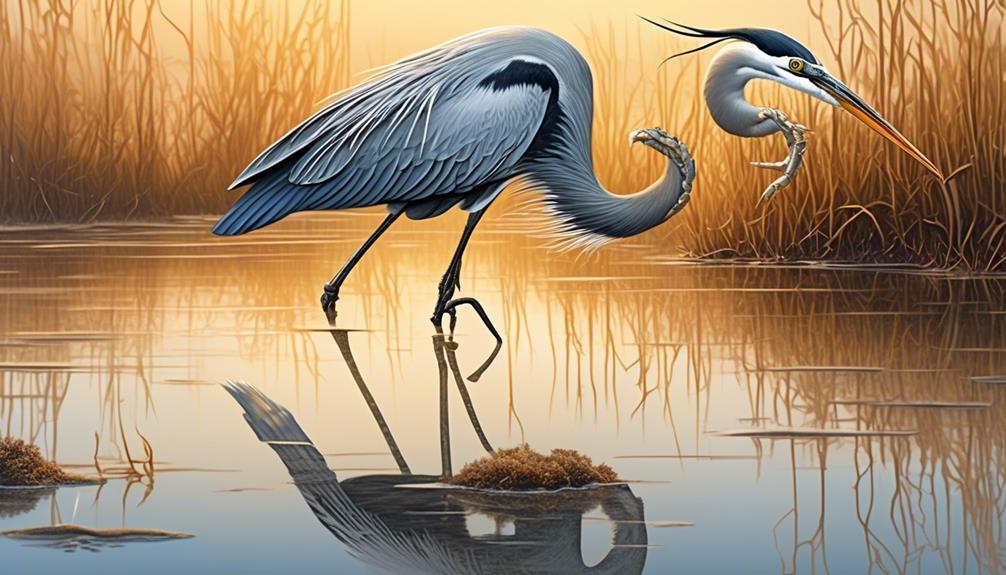
After exploring the dietary habits of dolphins, it’s now time to shift our focus to the subtopic of herons, fascinating coastal and seawater birds belonging to the Ardeidae family.
Herons are carnivorous birds with long necks and legs. When flying, they retract their necks. These elegant birds have a varied diet that includes amphibians, reptiles, aquatic insects, mollusks, and crabs. Some herons also opportunistically eat rodents, snails, and bird eggs.
Herons are skilled hunters, using their sharp beaks to catch their prey. They wade through shallow water, patiently waiting for the perfect opportunity to strike. Once they spot their target, they swiftly extend their necks and strike with precision and accuracy. Their long legs allow them to navigate through the water with ease, making them effective hunters in both coastal and freshwater environments.
Crabs are an important part of the heron’s diet, providing essential nutrients and energy. With their strong beaks, herons can crack open the hard shells of crabs and extract the meat inside. These birds are able to adapt their hunting techniques depending on the size and species of the crab they’re targeting.
Seagulls
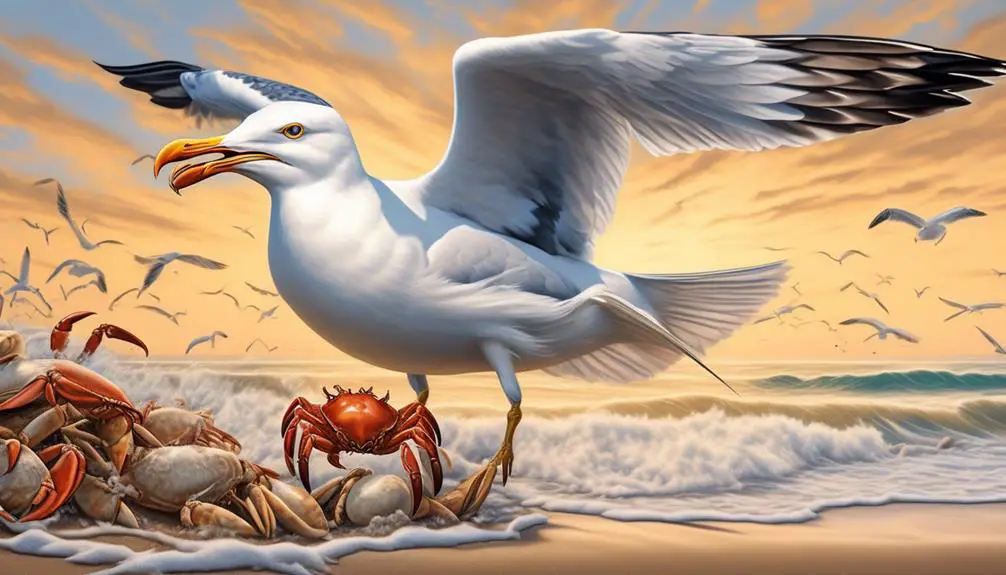
Seagulls, also known as gulls, are cosmopolitan seabirds that belong to the Laridae family. They’ve a wide distribution and can be found breeding on every continent. Seagulls scavenge opportunistically and consume a variety of prey, including small birds, fishes, mollusks, and crabs. They’re known to eat both dead and living crabs, making them important predators in coastal ecosystems.
Seagulls have a range of colors, varying from grey to white, with black markings on their wings or head. Their beak is adapted for picking and tearing apart food, allowing them to efficiently consume crabs. These birds are equipped with strong wings and excellent flying abilities, which aids them in locating and capturing their prey.
Seagulls are highly adaptable and have successfully colonized a variety of habitats, including urban areas, where they scavenge for food from human activities. They’re often seen near coastlines, where they feed on crabs found in intertidal zones or shallow waters. Their ability to consume crabs contributes to the regulation of crab populations and the maintenance of ecosystem balance.
Alligators
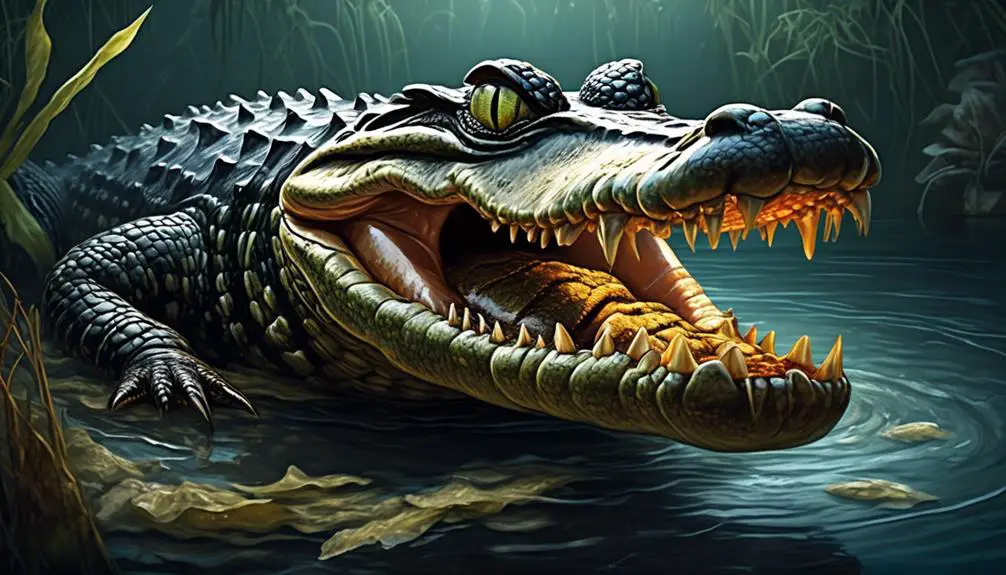
Alligators, belonging to the Alligatoridae family, exhibit specific feeding habits and are known to consume crabs. Juvenile alligators primarily feed on invertebrates, amphibians, insects, small fish, and crabs.
As they grow, full-grown alligators expand their diet to include a variety of prey such as snakes, fish, small mammals, birds, and turtles.
With their dark skin color and white undersides, American alligators can reach impressive lengths of up to 4.4 meters and weigh over 450 kg.
Alligator Feeding Habits
Alligators, members of the Alligatoridae family, display diverse feeding habits that encompass a wide range of prey, including invertebrates, amphibians, insects, small fish, and even crabs. Juvenile alligators primarily feed on these small aquatic organisms, utilizing their powerful jaws and sharp teeth to capture and consume their prey. As they grow, full-grown alligators expand their diet to include larger animals such as snakes, fish, small mammals, birds, and turtles. American alligators, the largest species of alligator, can reach lengths of up to 4.4 meters and weigh over 450 kg. To provide a visual representation of their feeding habits, here is a table showcasing the different prey items that alligators consume at different stages of their life:
| Alligator Life Stage | Prey Items |
|---|---|
| Juvenile | Invertebrates, Amphibians, Insects, Small Fish, Crabs |
| Full-Grown | Snakes, Fish, Small Mammals, Birds, Turtles, Crabs |
Crab Consumption by Alligators
Crabs are a significant component of the diet of alligators, particularly during their juvenile stage. Alligators, belonging to the Alligatoridae family, have a dark skin color and white undersides. While full-grown alligators consume snakes, fish, small mammals, birds, and turtles, juvenile alligators primarily feed on invertebrates, amphibians, insects, small fish, and crabs.
American alligators can reach lengths of up to 4.4 meters and weigh over 450 kg. Their ability to consume crabs is due to their strong jaws and sharp teeth, allowing them to crush the hard shells of the crabs. The consumption of crabs by alligators not only provides them with a source of nutrition but also contributes to the balance of ecosystems by controlling the crab population.
Otters
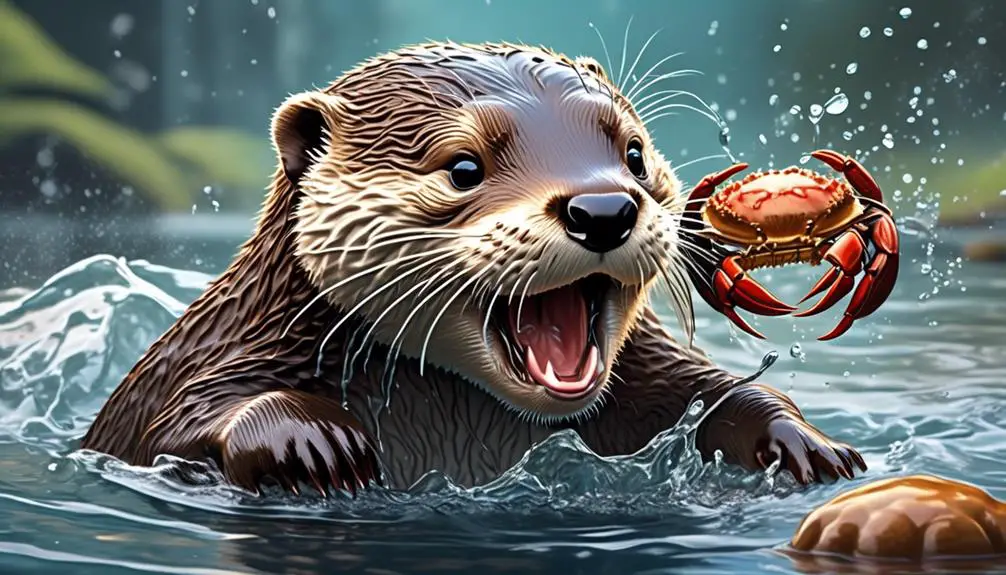
Otters, members of the Lutrinae subfamily, are carnivorous mammals known for their slim bodies, short limbs, and strong webbed feet. These adaptations make them highly efficient hunters in aquatic environments. Otters primarily feed on invertebrates and fish, but some species also consume crabs and crayfish.
Giant otters, found in South America, have a diverse diet that includes fish, but they also feed on crabs and other crustaceans. Their strong jaws allow them to crush the hard shells of crabs, enabling them to access the nutritious meat inside. Sea otters, on the other hand, are known for their ability to use rocks as tools to crack open crabs. They lie on their backs, placing the crab on their chest, and repeatedly strike it against the rock until the shell breaks.
Otters have a high metabolism and need to consume a large amount of food to sustain their energy levels. They’re skilled hunters, using their keen sense of smell and excellent underwater agility to locate and capture their prey. Their webbed feet and streamlined bodies allow them to swim swiftly and maneuver easily through the water, making them formidable predators.

Erzsebet Frey (Eli Frey) is an ecologist and online entrepreneur with a Master of Science in Ecology from the University of Belgrade. Originally from Serbia, she has lived in Sri Lanka since 2017. Eli has worked internationally in countries like Oman, Brazil, Germany, and Sri Lanka. In 2018, she expanded into SEO and blogging, completing courses from UC Davis and Edinburgh. Eli has founded multiple websites focused on biology, ecology, environmental science, sustainable and simple living, and outdoor activities. She enjoys creating nature and simple living videos on YouTube and participates in speleology, diving, and hiking.

